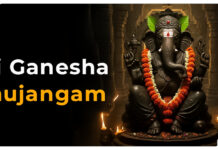
Right Size and Type of Lord Ganesha Idol: Scriptural Guidance for Worship
When it comes to worshipping Lord Ganesha, especially during the auspicious month of Bhadrapada, many devotees often wonder about the correct size, material, and immersion rules of the idol. The scriptures offer deep insights and symbolic significance behind every tradition, especially concerning the Varasiddhi Vinayaka Vratam and Ganesh Chaturthi celebrations.
What Should Be the Size of the Idol?
The ideal size of a Lord Ganesha idol meant for daily worship or for observances like Ganesh Chaturthi Vratam should never be too big. According to scriptural guidelines:
-
The idol should be of Vitasti size, which means palm-sized.
-
The reasoning is spiritual as well as practical.
“Yatha murti vruddhihi, tatha shanti hanihi” — “As the size of the idol increases, peace in the household diminishes.”
-
A larger idol may be suitable for public installations but not for homes, where simplicity and sattvik practices are encouraged.
What Material Should the Idol Be Made Of?
The scriptures clearly differentiate between Parthiva Murtis (earthen/clay idols) and those made of metal or ore (Dhatu Murti):
✅ Clay Idol (Parthiva Murti):
-
Must be used for Ganesh Chaturthi Vratam.
-
The idol should be made of clay or earth that dissolves in water.
-
It must be immersed after worship, as per the instruction:
“Kruthva Mahimayim Murtim” — meaning “Make an idol from earth.”
-
This aligns with the Parthiva Lingarchana done during Shiva worship as well.
-
The Sthula tattva (gross/earthly element) of the idol is returned to the Sukshma tattva (subtle/spiritual element) through immersion—symbolizing spiritual union and ego dissolution.
Metal/Stone Idol (Dhatu/Bhavana Murti):
-
Can be made of silver, gold, or other metals.
-
Not required to be immersed and can be used repeatedly.
-
However, even these should be no larger than palm size.
-
Ideal for nitya puja (daily worship), not for Vrat-based worship which requires Parthiva Murti.
Why Immersion (Visarjan) Is Important for Clay Idols
The process of immersion is not just ritualistic—it holds deep philosophical meaning:
-
The idol represents the Sthula tattva or form-based worship.
-
Water is associated with Sukshma tattva—a fluid, formless divine principle.
-
By immersing the idol, we symbolically merge the manifest with the unmanifest, letting go of form to embrace the divine essence.
-
This act represents detachment, surrender, and a return to the source.
Should the Idol Be Kept Forever?
-
Clay idols used for Varasiddhi Vinayaka Vratam or Ganesh Chaturthi must not be kept permanently.
-
Immersion is mandatory to complete the ritual cycle.
-
Metal or stone idols may be kept at home but must adhere to proper size and sanctity norms.
Vinayaka Chaviti Festival Related Posts
గణపతి ఆరాధన ఎలా చేయాలి? | How to Worship lord Ganesh in Telugu?
వినాయకుని పూజ ఏ విధంగా చేస్తే ఎటువంటి దోషం పోతుంది? | Ganesh Pooja for Dosha Nivarana in Telugu
శ్రీ మహావిష్ణువు లాగే వినాయకుడు కూడ అవతారాలు ఎత్తాడా?! వాటి చరిత్ర ఏమిటి?! | Incarnation of Ganesha
https://hariome.com/ganesh-chaturthi-lord-vinayaka-has-special-grace-zodiac-signs/
వినాయక చవితి పూజలో వాడే 21 పుజా పత్రాలు & విశిష్ఠత | Vinayaka Chavithi 21 Patri Names in Telugu
శివుడు నరికిన వినాయకుడి నిజమైన మనిషి తల ఎక్కడ ఉందో తెలుసా!? | Where is Ganesha’s Severed Human Head?










